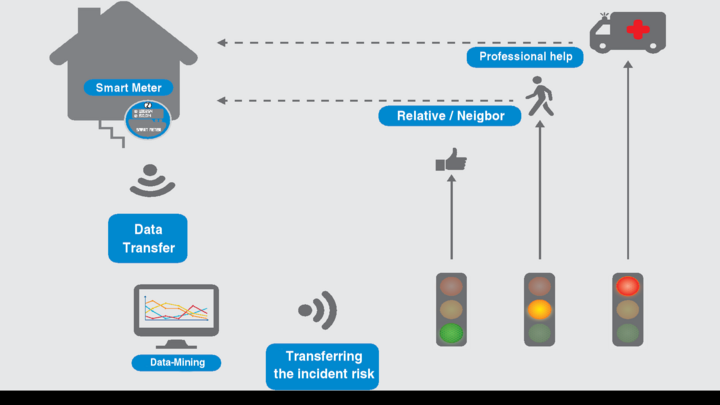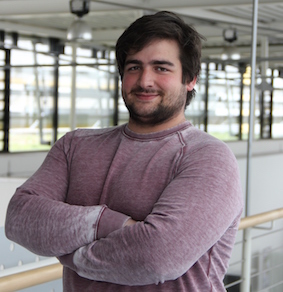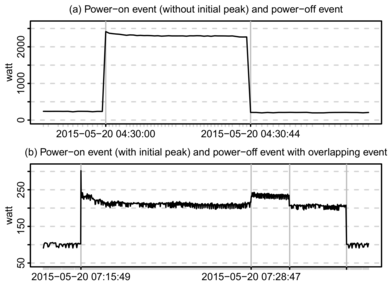Ambient Assisted Living in the Zelia Project: Lessons Learned
Matteo Cagnazzo, if(is), on monitoring power consumption as a non-invasive monitoring system to aid independent living

Image: Zelia

Matteo Cagnazzi, Researcher, if(is)
Listen to the audio interview with Matteo Cagnazzo on the Zelia project, or download it for later.
In many well-developed countries, the aging population is a big challenge (Teix2015). Due to personal preferences, budget restrictions or limited vacancies in retirement homes, elderly people often live in their own homes as long as possible. In doing so, the risk of unnoticed accidents and medical emergencies at home increases over time. The intention of Ambient Assisted Living systems (AAL systems) is to increase the security and comfort for these people. The aim of the Zelia project is to develop an AAL system that is able to detect accidents and medical emergencies just by using consumption data for electricity, natural gas, and water. Since every household in Germany must by law be equipped with an electronic power consumption meter in the near future, just this data is used in the first phase of the project (BMWE2015).
Carephones are the most common AAL-system on the market today (Schel2016). The functionality of this system depends on the ability of the users to trigger an alarm. Due to this, carephones are plagued by a large number of false alarms and missed incidents, i.e. the sensitivity and specificity of this system is low (Martin2010). Current non-interactive AAL-systems are often quite expensive and require the installation of sensors and devices in the living space itself. Due to the high costs and the related data privacy and data security issues, the acceptance of such systems is still low. Other reasons for the low propagation of more sophisticated AAL systems is the lack of business models and the lack of standardization (Rash2013).
Within the ZELIA project, the relevant issues mentioned above are explicitly addressed by the different project partners. Details of these are provided in the next section.
The concept of the developed AAL system is displayed in Illustration 1. The power consumption of a monitored household is recorded and transferred to a central server in real time. The prototypical IT architecture for this and the techniques implemented for data security and data privacy issues are briefly explained. On the central server, a number of certain patterns in the actual consumption data are also calculated in real time. If significant deviations from the corresponding typical patterns of the household are observed, an alarm is triggered.
Since the AAL system developed in the ZELIA project is intended to be used as a health care system, the requirements for the IT architecture in terms of data security and data integrity are high. At the same time, the entire system must be scalable to deal with an unknown number of participating households. The system must also be capable of dealing with large amounts of data, since the installed power meters capture the real power consumption (in watt) approximately every 1 to 8 seconds. Thus, up to 55,000 unequally-spaced observations are recorded and sent to the central server for each participating household every day.
To meet these requirements, a message-oriented middleware (MOM) with an asynchronous communication model was implemented. A detailed insight into the technical design of the platform is given in (Cagn2016).
As stated above, unequally-spaced, high frequency time series of the real power consumption are available for each household. To get an idea of the structure of these data and to sketch out some problems which arise when these data are used to monitor the well-being of seniors living on their own, Illustration 2 shows two short windows from one household.

Illustration 2: Two recorded activity profiles
Panel (a) displays a power-on and power-off event of an individual appliance which was in operation for 44 seconds in the middle of the night. In panel (b), one appliance was in operation for 20 minutes and 15 seconds. During this period another appliance was in use for 177 seconds. Notice that the first appliance in panel (b) caused an initial peak when it was activated. The number and types of the appliances in the households are unknown.
The monitoring itself is based on daily activity profiles. One day is defined as a period of 24 hours which starts at 4:00 in the morning. An activity profile is a set of quantities derived from stylized facts which as a whole represent the typical activity in a household. If a deviation from the typical activity profile is observed, this is regarded as indicative of a critical incident and an alarm is triggered. If a day passes by without an alarm, this day is considered to be a normal day and the data of this day are used to update the activity profile. In the update process, recent days are given more weight than days further in the past. Through this, the entire system adapts itself to possible changes in the composition of the household appliances or in the behavior of the senior citizen. A detailed overview of stylized and unstylized facts is given in (Cagn2016) and (Pasch2016)
Bibliography
- Cagn2016: Cagnazzo, M., Pascher, M., Meermeyer, M., Evers, S., Monitoring Energy Consumption to Derive the Welfare of Solitary Seniors, 2016
- BMWE2015: Federal Ministry for Economics and Energy, Baustein für die Energiewende: 7 Eckpunkte für das “Verordnungspaket Intelligente Netze", 2015
- Martin2010: Martin, S., Der ältere Mensch als Notfallpatient: Analyse medizinischer Charakteristika sowie sozialer und einsatztaktischer Begleitumstände, 2010
- Pasch2016: Pascher, M., Cagnazzo, M., Monitoring des Wohlergehens von alleinlebenden Senioren auf Basis von dezentral gemessenen Energieverbauchswerten, 2016
- Rash2013: Rashidi, P., Mihailidis, A., A Survey on Ambient-Assisted Living Tools for Older Adults, 2013
- Teix2015: Teixeira, R., Frey, W., Griffin, R., States of Change: The Demographic Evolution of the American Electorate, 1974-2060, 2015
- Schel2016: Schelisch, L., Technisch unterstütztes Wohnen im Stadtquartier - Potentiale, Akzeptanz und Nutzung eines Assistenzsystems für ältere Menschen, 2016
Please note: The opinions expressed in Industry Insights published by dotmagazine are the author's own and do not reflect the view of the publisher, eco – Association of the Internet Industry.


